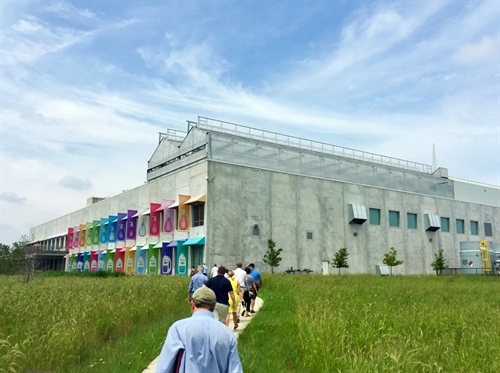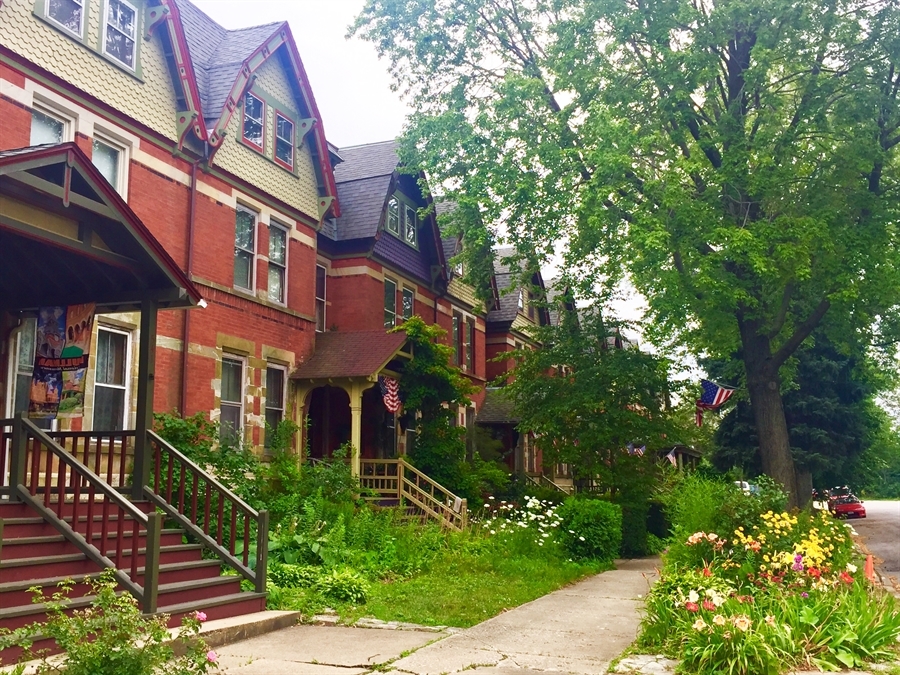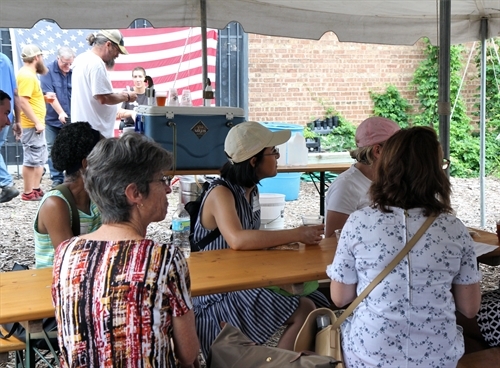
Angela Pauldine, Chicago Bungalow Association
National Park Superintendent Kathy Schneider explains Pullman's history
 By Angela Pauldine, Chicago Bungalow Association, @ChiBungalow
By Angela Pauldine, Chicago Bungalow Association, @ChiBungalow - August 17, 2017
On July 26, 2017, MPC led a walking tour in Pullman, winner of the 2016 Burnham Award for Excellence in Planning. Angela Pauldine, Director of Communications for the Chicago Bungalow Association, attended the tour with her colleagues.
Pullman is an extraordinary neighborhood. Many have heard of the national importance of Pullman’s history (most prominently, Labor Day was established after a nationwide strike that started at the Pullman factory!). But there’s another important story being written in Pullman today that has the power to inspire anyone who cares about underserved neighborhoods—which should be everyone.
That story also has the power to blow the mind of a 24-year-old newbie to the Chicago nonprofit world... and she’s here today to tell you why. My name is Angela and I’m the Director of Communications at the Chicago Bungalow Association (CBA), a nonprofit delegate agency of the City dedicated to strengthening Chicago's bungalows and vintage homes, and the neighborhoods and families they anchor (more on how later). Just two years ago, I got my bachelor’s degree in Art History and began working at CBA. Needless to say, I’m no expert in community revitalization. But what I learned on MPC’s walking tour of Pullman, winner of the 2016 Burnham Award for Excellence in Planning, really got me thinking. I asked myself: What does a thoughtful community revitalization plan that benefits all community members look like?
So, here’s what I learned on the tour about why it makes perfect sense that Pullman took the prize:
We all met up at Chicago Neighborhood Initiatives (CNI) on 111th Street. MPC’s VP, Josh Ellis, announced this was the first ever tour of a Burnham Award site! Then CNI President, David Doig, gave us an orientation on the work they’ve been doing in Pullman. He pointed out the window to a nearby Walmart and explained that its addition to Pullman was crucial for residents. Before, people had to trek all the way to Hyde Park for groceries and retail. Interestingly, since the pitch to bring in a Walmart was controversial, they had Walmart sign a Community Benefits Agreement to hire 80% of its employees from the area, accept unionized labor, have a $10 minimum wage (high for 2011 when the agreement was signed), and even have a green roof. Now about 400 people from the 60628 zip code are employed by that Walmart, providing that first job for young people which was lacking in the area before. And, coming soon is a Whole Foods distribution center, which will create even more jobs.

Angela Pauldine, Chicago Bungalow Association
The Method Home Products, Inc. factory (a.k.a. South Side Soapbox) with the Gotham Greens greenhouse atop.
Next stop was the Method factory, and on the roof of it, Gotham Greens. Recruited to Pullman by CNI in 2013 to create jobs (currently 100), the factory far exceeds standards of eco-friendliness. Method, who makes those colorful soaps and cleaning products you see on the shelves of stores like Target, is a B Corp and the only consumer goods factory to achieve LEED Platinum certification. Like Walmart, Method employs mostly members of the community. A high school degree/GED and a 60620/60628 area code get you a job interview. On the roof, the Gotham Greens urban farm provides more than 50 additional jobs.
In total, this commercial/industrial section of Pullman, called Pullman Park, provides 750 permanent jobs.
On our next stop, we learned about the additional 150 construction jobs created by CNI. On the 107th block of South Champlain, we were welcomed inside a historic Pullman rowhouse in the midst of rehabilitation. It’s one of many crumbling and vacant rowhouses being turned into move-in ready, owner-occupied affordable housing. Unlike the typical pattern of for-profit residential development, this development is targeted and community-driven. One block is developed at a time and stabilized before moving on to rehab the next block’s homes. Here, the corner liquor store that was creating problems for residents was replaced with a community garden and an active block club was established.

Angela Pauldine, Chicago Bungalow Association
Most astonishing to me, is that CNI specifically hires local at-risk youth through the Chicago Create Real Economic Destiny (CRED) program to do the demolition and cleanout before construction starts. CRED created a self-enrichment program where young men are paid and trained and even get jobs afterwards, signifying a graduation from the program. It was at this point when I started to think about “comprehensive development,” as David Doig called it. As he was saying this all very humbly and matter-of-factly, my brain was saying, “You mean to tell me a community with a long history of being neglected is actually having its needs addressed? You mean to tell me not only are investments being made in industrial/commercial development, but also in vintage homes and the quality of people's lives? You mean to tell me a developer can actually have a conscience?”

Gabriel Charles Tyler, MPC
There I am in the center enjoying a much-needed cold beer at Argus Brewery, the final stop on the tour.
While I was admittedly floored by the conscientiousness, as Millennials are prescriptively cynical, I was also reminded of our work at the Chicago Bungalow Association. We are also in the business of investing in underserved neighborhoods. It comes in the form of educational resources like free home maintenance seminars at local libraries, and energy efficiency grants for low- and moderate-income households that lower utility bills and energy usage, extend the life of vintage homes, and raise property values. Through the grants we’ve given to homeowners since our founding in 2000, we’ve invested $14 million in revitalizing neighborhoods one vintage home at a time. We target this investment in neighborhoods on the South Side that need it most—79% of our grants have gone to South Side homes. But let’s get back to the tour.
We then traipsed around the rest of the beautiful National Park, from the imposing Clock Tower and Administration Building to the charming Hotel Florence. We learned from National Park Superintendent, Kathy Schneider, and 20-year Pullman resident, Arthur Melville Pearson, that Pullman was one of the first comprehensively planned developments. The neighborhood was designed around the Pullman factory to provide housing and everything else the laborers would need. So the beautiful thing is that today’s “comprehensive development” of Pullman is a continued tradition. Today, the Pullman National Monument is the spur for the community’s revitalization, but this time, the development benefits all community members. This would not have been possible without those historical heroes in Pullman who sparked workers’ rights and civil rights movements.
During President Obama’s designation speech in 2015, he honored that extraordinary story of Pullman, explaining that while the National Monument aims to preserve Pullman’s buildings, “part of what we’re preserving here is also history.” He went on to say, “It’s also understanding that places that look ordinary are nothing but extraordinary. The places you live are extraordinary, which means you can be extraordinary. You can make something happen, the same way these workers here at Pullman made something happen.”
Pullman is indeed extraordinary.
For a recap of MPC’s Pullman tour, check out our live Tweets from the event.